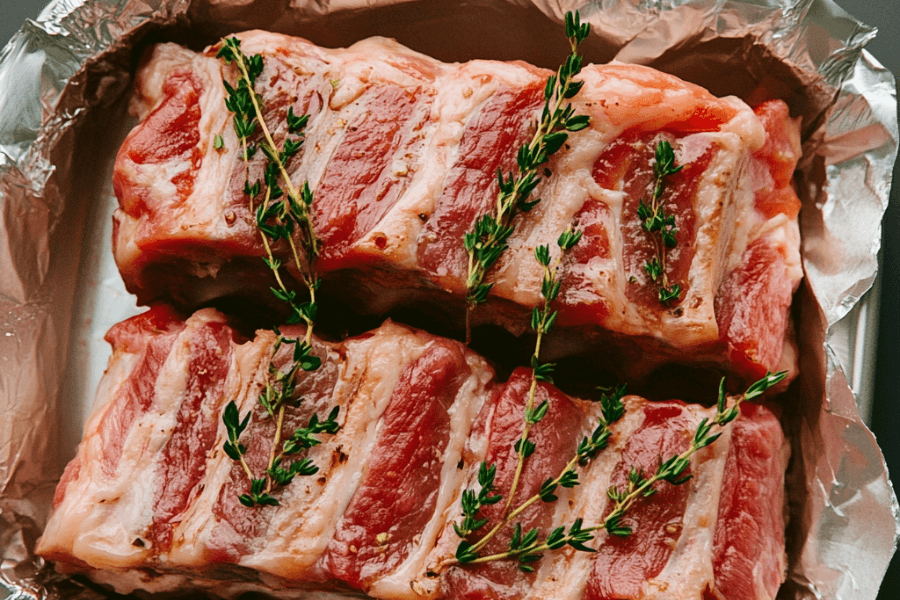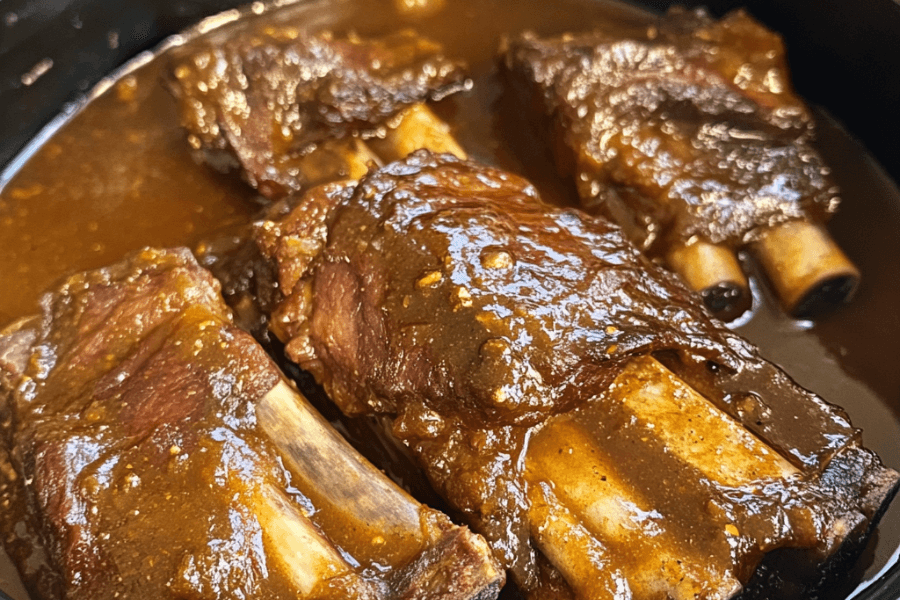1. Why Slow Cookers Are Perfect for Ribs
When preparing ribs in a slow cooker, one of the most common questions is, “Should ribs be covered in liquid?” Understanding the right technique is essential for achieving tender, flavorful ribs every time. In this guide, we’ll explore whether covering ribs in liquid is necessary, how much liquid to use, and the best practices for slow-cooking ribs to perfection.
2. The Role of Liquid in Slow Cooking
One of the biggest misconceptions about slow cooking is that food must always be submerged in liquid. While this might be true for certain recipes like soups and stews, ribs are a different story.
- Why Liquid Is Used: The primary function of liquid in slow cooking is to create steam, which helps to cook the food evenly. This is particularly important for tough cuts of meat like ribs, as the steam helps to tenderize the meat over time.
- Moisture Balance: Too much liquid can result in soggy ribs, while too little liquid can lead to dryness. The goal is to find the right balance for your desired texture.
How Liquid Works in a Slow Cooker
When you add liquid to a slow cooker, it heats up and turns into steam, which circulates within the sealed environment. This steam ensures that the meat cooks thoroughly while retaining its moisture. For ribs, this means they’ll stay tender and flavorful without drying out.
Table of Contents
3. How Much Liquid Should You Use for Ribs?
The amount of liquid you use depends on the type of ribs you’re cooking and your preferred method. Here’s a general guide:
- Baby Back Ribs: These are naturally tender and require minimal liquid. About 1/4 to 1/2 cup of liquid at the bottom of the slow cooker is usually sufficient.
- Spare Ribs: These are larger and tougher, so you may need closer to 1 cup of liquid to ensure they cook properly.
- Country-Style Ribs: These are meatier and often benefit from 1 to 1.5 cups of liquid.
Pro Tip:
Always ensure the liquid covers the bottom of the slow cooker but doesn’t necessarily submerge the ribs. This allows the ribs to steam and baste in their own juices while preventing them from becoming waterlogged.
4. Best Liquids to Use for Flavorful Ribs
The type of liquid you use can significantly impact the flavor of your ribs. Here are some popular options:
- Barbecue Sauce: A classic choice for sweet and tangy ribs. Dilute it slightly with water or broth to prevent it from burning.
- Broth: Beef, chicken, or vegetable broth adds depth and savory flavor.
- Apple Juice or Cider: These add a hint of sweetness and pair beautifully with pork ribs.
- Beer: A robust option for adding rich, malty flavors.
- Vinegar: Particularly apple cider vinegar, which enhances the meat’s natural flavor and tenderizes it.
Combination Ideas
For extra flavor, try mixing liquids. For example, combine apple juice with barbecue sauce, or use broth with a splash of beer or vinegar.
5. Should You Submerge the Ribs Completely?
The question of whether ribs should be fully submerged in liquid while cooking in a slow cooker often comes down to personal preference and the desired texture of the finished dish. However, from a culinary standpoint, fully submerging ribs in liquid is generally not recommended for several reasons:
Why Ribs Shouldn’t Be Fully Submerged
- Steam-Based Cooking
Slow cookers are designed to use steam to cook food. Even if you use only a small amount of liquid, the closed environment of the slow cooker traps steam, which circulates and cooks the meat thoroughly. Fully submerging the ribs eliminates the need for this steam-based cooking and can lead to soggier ribs rather than tender ones. - Flavor Dilution
Submerging ribs completely in liquid can dilute the flavors of your spices, rubs, and marinades. Instead of the ribs developing a rich, concentrated taste, they may end up tasting more like boiled meat. Allowing the ribs to sit above or partially in the liquid ensures the natural flavors of the meat and seasonings shine through. - Perfect Texture
When ribs are partially submerged, the exposed portion cooks in steam while the submerged portion absorbs moisture and flavor. This balance creates tender meat with a slight crust on the outside, which is ideal for achieving that signature “fall-off-the-bone” texture.
How to Arrange Ribs in the Slow Cooker
To maximize flavor and ensure even cooking, the placement of the ribs in the slow cooker matters. Here are some tips:
- Spiral or Vertical Arrangement:
Stand the ribs up vertically or spiral them around the edges of the slow cooker. This allows the liquid to circulate evenly while exposing some parts of the ribs to steam. - Layering:
If you’re cooking multiple racks of ribs, layer them in an overlapping pattern rather than stacking them flat. Place a small amount of liquid at the bottom to ensure each layer benefits from steam circulation. - Add Aromatics:
Consider placing onions, garlic, or slices of citrus under the ribs. These ingredients will infuse the liquid with extra flavor and prevent the ribs from sitting directly on the bottom of the cooker, which can lead to uneven cooking.
How Much Liquid Should Be Used?
- Base Layer of Liquid:
A small amount of liquid is all that’s necessary—just enough to cover the bottom of the slow cooker. Depending on the size of your slow cooker and the number of ribs, this usually amounts to 1/4 to 1 cup of liquid. - What Happens During Cooking:
As the ribs cook, they release their own juices, increasing the liquid in the slow cooker. This makes it unnecessary to add a large amount of liquid at the start.
Comparison: Fully Submerged vs. Partially Submerged Ribs
| Aspect | Fully Submerged | Partially Submerged |
| Flavor | Diluted, weaker seasoning | Concentrated, rich flavor |
| Texture | Soggy, overly soft | Tender with a slight crust |
| Cooking Method | Boiling effect | Steam-based cooking |
| Visual Appeal | Lacks caramelization | Beautifully caramelized exterior |
Exceptions: When to Submerge Ribs
There are a few scenarios where fully submerging ribs might be appropriate:
- For Brothy Dishes:
If you’re making a soup or stew with ribs, submerging them is necessary to integrate the meat with the liquid. - Preference for Softer Texture:
If you enjoy extremely soft, almost shredded ribs, fully submerging them in liquid might be a better choice.
Pro Tip: Finishing for the Perfect Ribs
To achieve a crispy, caramelized exterior, consider transferring the ribs to an oven or grill after slow cooking.
- Broil in the Oven: Brush the ribs with your favorite barbecue sauce and broil them on high for 5-10 minutes until the surface is slightly charred.
- Grill: Place the ribs on a hot grill, brushing them with sauce as you go. This adds a smoky, charred flavor that complements the tender meat.
By avoiding full submersion and opting for partial immersion or steam-based cooking, you can unlock the full potential of your slow-cooked ribs. This approach ensures the ribs stay tender and flavorful while maintaining a satisfying texture and rich taste
6. Techniques for Maximizing Flavor
Cooking ribs in a slow cooker offers incredible convenience, but to make them truly unforgettable, you need to focus on maximizing flavor. From seasoning and marinades to cooking techniques and finishing touches, there are many ways to elevate your slow-cooked ribs to restaurant-quality. Below, we’ll explore the most effective methods to ensure your ribs are packed with flavor in every bite.
1. Use a Flavorful Spice Rub
The foundation of delicious ribs begins with a well-balanced spice rub. A good rub enhances the natural flavor of the meat and adds layers of complexity. Here’s how to create a perfect rub:
Ingredients for a Basic Rib Rub:

- Paprika: Adds a smoky, earthy undertone.
- Brown Sugar: Balances the spices with a touch of sweetness.
- Garlic Powder and Onion Powder: Provide savory depth.
- Chili Powder or Cayenne: For a hint of heat.
- Salt and Black Pepper: Essential for enhancing flavor.
Tips for Applying the Rub:
- Pat the ribs dry with paper towels before applying the rub to ensure it sticks.
- Generously coat both sides of the ribs and massage the rub into the meat for better absorption.
- For maximum flavor, let the ribs sit with the rub on them for at least 1-2 hours, or overnight in the refrigerator.
2. Marinate for Extra Depth
Marinating your ribs before slow cooking is another way to enhance their flavor. A good marinade infuses the meat with moisture and complementary flavors.
Best Marinades for Ribs:
- Classic BBQ Marinade: Combine barbecue sauce, Worcestershire sauce, and a splash of apple cider vinegar.
- Asian-Style Marinade: Use soy sauce, ginger, garlic, honey, and sesame oil.
- Citrus-Based Marinade: Mix orange juice, lime juice, and fresh herbs for a bright, zesty flavor.
Pro Tip:
Place the ribs in a resealable plastic bag with the marinade and refrigerate them for 4-6 hours, or overnight for stronger flavors.
3. Sear the Ribs Before Slow Cooking
Searing the ribs in a hot skillet before adding them to the slow cooker creates a flavorful crust and locks in juices. This step also enhances the visual appeal of the ribs by adding caramelization.
How to Sear Ribs:
- Heat a skillet or grill pan over medium-high heat.
- Add a small amount of oil and sear the ribs for 2-3 minutes per side until golden brown.
- Once seared, transfer the ribs to the slow cooker and proceed with your recipe.
4. Layer Aromatics for Flavor Infusion
Adding aromatic vegetables and herbs to the bottom of the slow cooker is an excellent way to infuse your ribs with subtle yet impactful flavors.
Aromatic Options:
- Onions: Add sweetness and depth.
- Garlic: Imparts a robust, savory flavor.
- Fresh Herbs: Thyme, rosemary, or bay leaves work well.
- Citrus Slices: Lemons or oranges add a refreshing tang.
Layer these ingredients under the ribs to ensure they release their flavors into the cooking liquid.
5. Use the Right Cooking Liquid
The liquid you add to the slow cooker doesn’t just prevent the ribs from drying out—it also contributes significantly to their flavor.
Top Choices for Cooking Liquid:
- Barbecue Sauce: Adds a tangy, smoky flavor.
- Apple Juice or Cider: Sweet and complements pork ribs beautifully.
- Beer or Stout: Provides a rich, earthy undertone.
- Broth: Beef or chicken broth enhances the savory profile of the meat.
Tip:
Use just enough liquid to cover the bottom of the slow cooker. This allows the ribs to steam and baste without becoming soggy.
6. Baste During Cooking
Basting the ribs with sauce or cooking liquid during the slow cooking process ensures every inch of the meat is coated in flavor.
When to Baste:
- Start basting halfway through the cooking process.
- Use a brush or spoon to coat the ribs with your desired sauce every hour.
This step not only enhances flavor but also helps create a sticky, caramelized glaze.
7. Finish in the Oven or Grill
For perfectly caramelized ribs, transfer them to the oven or grill after slow cooking. This finishing step adds texture and locks in the final layer of flavor.
How to Finish Ribs:
- Preheat the oven to 425°F (220°C) or heat your grill to medium-high.
- Brush the ribs generously with barbecue sauce or glaze.
- Place the ribs on a baking sheet (if using an oven) or directly on the grill grates.
- Cook for 10-15 minutes until the sauce is bubbling and slightly charred.
8. Enhance with a Final Glaze
A glaze adds a glossy, flavorful finish to your ribs. You can use a pre-made barbecue sauce or make your own.
Homemade Glaze Recipe:
- 1/2 cup barbecue sauce
- 2 tablespoons honey
- 1 tablespoon apple cider vinegar
- 1 teaspoon smoked paprika
Brush the glaze over the ribs during the final few minutes of cooking in the oven or on the grill for a sticky, irresistible coating.
9. Let the Ribs Rest Before Serving
After cooking, allow the ribs to rest for 5-10 minutes before cutting. This step ensures the juices redistribute throughout the meat, keeping the ribs moist and flavorful.
10. Pair with the Right Sides
No rib dish is complete without delicious sides. Serve your slow-cooked ribs with:
- Coleslaw for a refreshing crunch.
- Baked beans for a hearty, smoky complement.
- Cornbread or garlic bread to soak up the juices.
By following these techniques, you can elevate your slow-cooked ribs from simple to sensational. From the spice rub to the finishing glaze, every step contributes to creating a dish bursting with flavor. Whether you’re hosting a barbecue or preparing a cozy dinner, these tips will help you deliver ribs that are truly unforgettable.
7. FAQs
1. Can You Cook Ribs Without Any Liquid in the Slow Cooker?
While it’s possible, adding at least a small amount of liquid ensures the ribs don’t dry out.
2. What’s the Best Temperature Setting for Ribs?
Low heat (around 200°F to 250°F) is ideal for tender ribs.
3. How Long Should Ribs Cook in a Slow Cooker?
Cook on low for 6-8 hours or on high for 3-4 hours, depending on the thickness of the ribs.
4. Do I Need to Flip the Ribs During Cooking?
It’s not necessary, but flipping them halfway can ensure even cooking.
5. Can I Add Vegetables with the Ribs?
Absolutely! Onions, carrots, and potatoes can be added for a complete meal.
6. What’s the Best Way to Store Leftover Ribs?
Store them in an airtight container in the fridge for up to 3 days. Reheat in the oven or microwave.
What Liquids Work Best?
From broths to marinades, the type of liquid you use affects the flavor of your ribs. For a tangy and smoky option, consider adapting elements from this homemade Sloppy Joe seasoning to create a unique base.
Tips for Tender Ribs
To get that perfect fall-off-the-bone texture, ensure you use the right cooking technique. For an in-depth guide, explore how to make ribs tender and flavorful and elevate your slow-cooking game.
Pairing Ribs with Delicious Sides
Ribs pair wonderfully with a variety of side dishes. For lighter options, try serving them alongside these crispy salmon bites or a refreshing simple crab salad.
8. Conclusion: Achieving the Best Ribs in Your Slow Cooker
Slow cooking ribs is an art that combines technique, flavor, and patience. While it’s not necessary to fully submerge ribs in liquid, adding just the right amount can make all the difference in achieving tender, flavorful results. By choosing the right liquid, seasoning the ribs properly, and following the tips outlined above, you can create a dish that’s sure to impress family and friends.
For those who love experimenting with flavors, slow-cooked ribs provide endless opportunities to get creative. Whether you prefer a smoky barbecue sauce or a sweet apple glaze, the slow cooker is your best ally in achieving perfectly cooked ribs every time.

